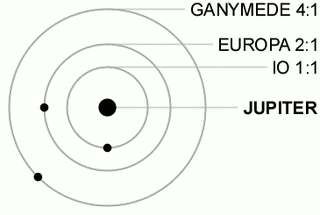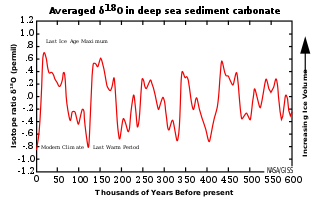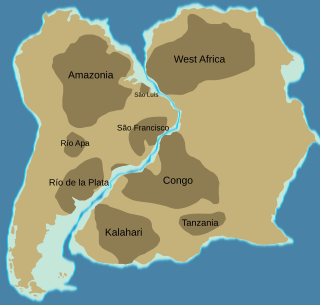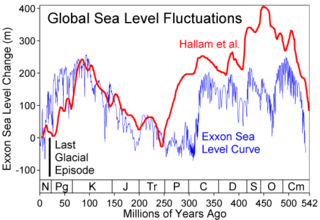Related Research Articles

In celestial mechanics, orbital resonance occurs when orbiting bodies exert regular, periodic gravitational influence on each other, usually because their orbital periods are related by a ratio of small integers. Most commonly this relationship is found for a pair of objects. The physical principle behind orbital resonance is similar in concept to pushing a child on a swing, where the orbit and the swing both have a natural frequency, and the other body doing the "pushing" will act in periodic repetition to have a cumulative effect on the motion. Orbital resonances greatly enhance the mutual gravitational influence of the bodies. In most cases, this results in an unstable interaction, in which the bodies exchange momentum and shift orbits until the resonance no longer exists. Under some circumstances, a resonant system can be stable and self-correcting, so that the bodies remain in resonance. Examples are the 1:2:4 resonance of Jupiter's moons Ganymede, Europa and Io, and the 2:3 resonance between Pluto and Neptune. Unstable resonances with Saturn's inner moons give rise to gaps in the rings of Saturn. The special case of 1:1 resonance between bodies with similar orbital radii causes large Solar System bodies to eject most other bodies sharing their orbits; this is part of the much more extensive process of clearing the neighbourhood, an effect that is used in the current definition of a planet.
The Snowball Earth hypothesis proposes that during one or more of Earth's icehouse climates, Earth's surface became entirely or nearly entirely frozen, sometime earlier than 650 Mya during the Cryogenian period. Proponents of the hypothesis argue that it best explains sedimentary deposits generally regarded as of glacial origin at tropical palaeolatitudes and other enigmatic features in the geological record. Opponents of the hypothesis contest the implications of the geological evidence for global glaciation and the geophysical feasibility of an ice- or slush-covered ocean and emphasize the difficulty of escaping an all-frozen condition. A number of unanswered questions remain, including whether the Earth was a full snowball, or a "slushball" with a thin equatorial band of open water.

Callisto, or Jupiter IV, is the second-largest moon of Jupiter, after Ganymede. It is the third-largest moon in the Solar System after Ganymede and Saturn's largest moon Titan, and the largest object in the Solar System that may not be properly differentiated. Callisto was discovered in 1610 by Galileo Galilei. At 4821 km in diameter, Callisto has about 99% the diameter of the planet Mercury but only about a third of its mass. It is the fourth Galilean moon of Jupiter by distance, with an orbital radius of about 1883000 km. It is not in an orbital resonance like the three other Galilean satellites—Io, Europa, and Ganymede—and is thus not appreciably tidally heated. Callisto's rotation is tidally locked to its orbit around Jupiter, so that the same hemisphere always faces inward. Because of this, there is a sub-Jovian point on Callisto's surface, from which Jupiter would appear to hang directly overhead. It is less affected by Jupiter's magnetosphere than the other inner satellites because of its more remote orbit, located just outside Jupiter's main radiation belt.

Marl or marlstone is a calcium carbonate or lime-rich mud or mudstone which contains variable amounts of clays and silt. The dominant carbonate mineral in most marls is calcite, but other carbonate minerals such as aragonite, dolomite, and siderite may be present. Marl was originally an old term loosely applied to a variety of materials, most of which occur as loose, earthy deposits consisting chiefly of an intimate mixture of clay and calcium carbonate, formed under freshwater conditions; specifically an earthy substance containing 35–65% clay and 65–35% carbonate. It also describes a habit of coralline red alga. The term is today often used to describe indurated marine deposits and lacustrine (lake) sediments which more accurately should be named 'marlstone'. Marlstone is an indurated rock of about the same composition as marl, more correctly called an earthy or impure argillaceous limestone. It has a blocky subconchoidal fracture, and is less fissile than shale. The term 'marl' is widely used in English-language geology, while the terms Mergel and Seekreide are used in European references.

Climate variability includes all the variations in the climate that last longer than individual weather events, whereas the term climate change only refers to those variations that persist for a longer period of time, typically decades or more. In the time since the industrial revolution the climate has increasingly been affected by human activities that are causing global warming and climate change.
In astronomy, axial tilt, also known as obliquity, is the angle between an object's rotational axis and its orbital axis, or, equivalently, the angle between its equatorial plane and orbital plane. It differs from orbital inclination.

Milankovitch cycles describe the collective effects of changes in the Earth's movements on its climate over thousands of years. The term is named for Serbian geophysicist and astronomer Milutin Milanković. In the 1920s, he hypothesized that variations in eccentricity, axial tilt, and precession resulted in cyclical variation in the solar radiation reaching the Earth, and that this orbital forcing strongly influenced climatic patterns on Earth.
The Rhaetian is the latest age of the Triassic period or the uppermost stage of the Triassic system. It was preceded by the Norian and succeeded by the Hettangian. The base of the Rhaetian lacks a formal GSSP, though candidate sections include Steinbergkogel in Austria and Pignola-Abriola in Italy. The end of the Rhaetian is more well-defined. According to the current ICS system, the Rhaetian ended 201.3 ± 0.2 Ma.

The geology of Mars is the scientific study of the surface, crust, and interior of the planet Mars. It emphasizes the composition, structure, history, and physical processes that shape the planet. It is analogous to the field of terrestrial geology. In planetary science, the term geology is used in its broadest sense to mean the study of the solid parts of planets and moons. The term incorporates aspects of geophysics, geochemistry, mineralogy, geodesy, and cartography. A neologism, areology, from the Greek word Arēs (Mars), sometimes appears as a synonym for Mars's geology in the popular media and works of science fiction.

The 100,000-year problem of the Milankovitch theory of orbital forcing refers to a discrepancy between the reconstructed geologic temperature record and the reconstructed amount of incoming solar radiation, or insolation over the past 800,000 years. Due to variations in the Earth's orbit, the amount of insolation varies with periods of around 21,000, 40,000, 100,000, and 400,000 years. Variations in the amount of incident solar energy drive changes in the climate of the Earth, and are recognised as a key factor in the timing of initiation and termination of glaciations.
PSR B1828-11 is a pulsar approximately 10,000 light-years away in the constellation of Scutum. The star exhibits variations in the timing and shape of its pulses: this was at one stage interpreted as due to a possible planetary system in orbit around the pulsar, though the model required an anomalously large second period derivative of the pulse times. The planetary model was later discarded in favour of precession effects as the planets could not cause the observed shape variations of the pulses. While the generally accepted model is that the pulsar is a neutron star undergoing free precession, a model has been proposed that interprets the pulsar as a quark star undergoing forced precession due to an orbiting "quark planet". The entry for the pulsar on SIMBAD lists this hypothesis as being controversial.

The Sorbas Basin is a sedimentary basin around the town of Sorbas in Almeria Province in south-east Spain. It is believed to have been formed by extension, between two fault-bounded blocks which rotated anti-clockwise to take up the compression resulting from Europe's collision with Africa. The basin is filled with turbidites and evaporites of the Tortonian-Messinian ages of the Miocene Epoch.

In celestial mechanics, apsidal precession is the precession of the line connecting the apsides of an astronomical body's orbit. The apsides are the orbital points closest (periapsis) and farthest (apoapsis) from its primary body. The apsidal precession is the first time derivative of the argument of periapsis, one of the six main orbital elements of an orbit. Apsidal precession is considered positive when the orbit's axis rotates in the same direction as the orbital motion. An apsidal period is the time interval required for an orbit to precess through 360°.

The São Francisco Craton is an ancient craton in the eastern part of South America. The craton crops out in the Brazilian states of Minas Gerais and Bahia.
North African climate cycles have a unique history that can be traced back millions of years. The cyclic climate pattern of the Sahara is characterized by significant shifts in the strength of the North African Monsoon. When the North African Monsoon is at its strongest, annual precipitation and consequently vegetation in the Sahara region increase, resulting in conditions commonly referred to as the "green Sahara". For a relatively weak North African Monsoon, the opposite is true, with decreased annual precipitation and less vegetation resulting in a phase of the Sahara climate cycle known as the "desert Sahara".
The Late Ordovician Glaciation is the first part of the Andean-Saharan glaciation. It was centered on the Sahara region in late Ordovician, about 440–460 Ma. The major glaciation during this period is widely considered to be the leading cause of the Ordovician-Silurian extinction event. Evidence of this glaciation can be seen in places such as Morocco, South Africa, Libya, and Wyoming. More evidence derived from isotopic data is that during the Late Ordovician, Tropical ocean temperatures were about 5 °C cooler than present day, this would have been a major factor that aided in the glaciation process.

Lawrence Alexander Hardie was an American geologist, sedimentologist, and geochemist. For nearly 50 years, he mentored students and pursued research as a Professor at Johns Hopkins University (JHU) in Baltimore MD in the Department of Earth and Planetary Sciences. He authored or co-authored many scientific papers and several books.

Global or eustatic sea level has fluctuated significantly over Earth's history. The main factors affecting sea level are the amount and volume of available water and the shape and volume of the ocean basins. The primary influences on water volume are the temperature of the seawater, which affects density, and the amounts of water retained in other reservoirs like rivers, aquifers, lakes, glaciers, polar ice caps and sea ice. Over geological timescales, changes in the shape of the oceanic basins and in land/sea distribution affect sea level. In addition to eustatic changes, local changes in sea level are caused by tectonic uplift and subsidence.

A circumstellar disc is a torus, pancake or ring-shaped accumulation of matter composed of gas, dust, planetesimals, asteroids, or collision fragments in orbit around a star. Around the youngest stars, they are the reservoirs of material out of which planets may form. Around mature stars, they indicate that planetesimal formation has taken place and around white dwarfs, they indicate that planetary material survived the whole of stellar evolution. Such a disc can manifest itself in various ways.
PX Andromedae is an eclipsing cataclysmic variable star in the constellation Andromeda. It has been classified as a SW Sextantis variable, and its apparent visual magnitude varies between 14.04 and 17.
References
- ↑ W. Krijgsman; A. R. Fortuinb; F. J. Hilgen; F. J. Sierrod (2001). "Astrochronology for the Messinian Sorbas basin (SE Spain) and orbital (precessional) forcing for evaporite cyclicity". Sedimentary Geology . 140 (1–2): 43–60. Bibcode:2001SedG..140...43K. doi:10.1016/S0037-0738(00)00171-8. hdl: 1874/1632 .
- ↑ Meyers, S.R. (2008). "Resolving Milankovitchian controversies: The Triassic Latemar Limestone and the Eocene Green River Formation". Geology . 36 (4): 319–322. Bibcode:2008Geo....36..319M. doi:10.1130/G24423A.1. S2CID 49582867.
| This geochronology article is a stub. You can help Wikipedia by expanding it. |